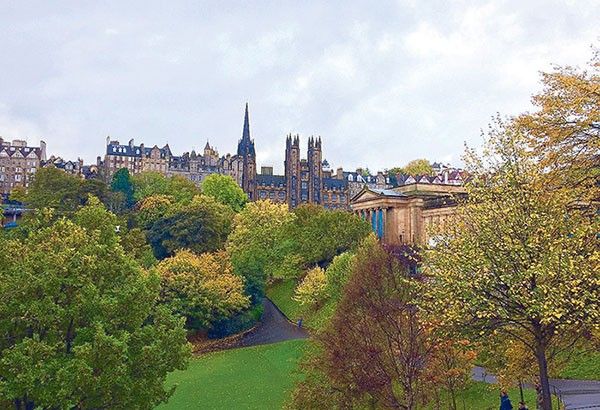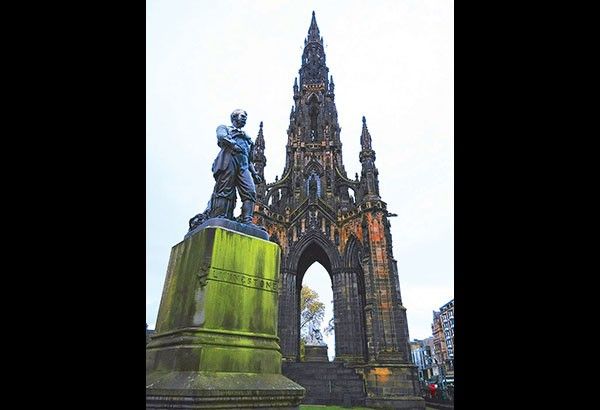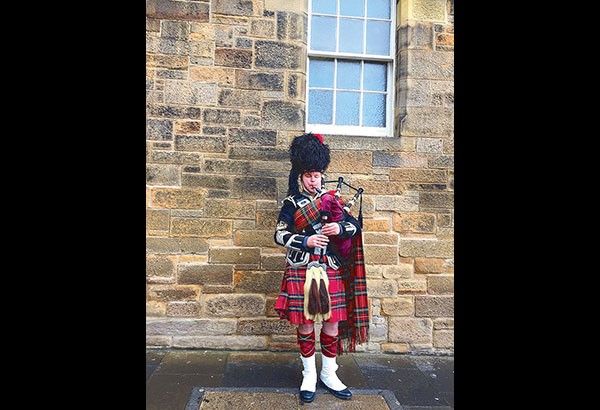Edifying Edinburgh

Our trip to Edinburgh began in a train station that immortalizes a literary landmark, Harry Potter’s Platform, 9 ¾ (Read: Nine and three quarters), where the imaginary Hogwarts Express begins.
As we waited for our train from London’s King’s Cross Station to Edinburgh’s Waverley Station, my son Chino and I joined the queue to have our photo taken on the supposed location of the platform, where a luggage trolley is “stuck” halfway through the wall.
(I was to later read that Harry Potter author J.K. Rowling’s parents met at King’s Cross and that she herself conceived of writing a book about wizardry while on a train.)
Our scenic four-hour journey from London to Edinburgh ended at the Waverley station, a hub named after one of the works of renowned Scottish author Sir Walter Scott (whose other works include Ivanhoe and The Lady of the Lake).
Near the train station, in between Edinburgh’s Old Town and New Town, is the Scott Monument on Princes Street. It is the largest monument to a writer in the world.
From Waverley, my husband, son and I lugged our carry-ons on steep winding uphill cobblestoned roads to the Royal Mile, the city’s most prominent artery located in a section called the “Old Town.” One of the arched openings along the Royal Mile leads to a courtyard or “close,” called The Lady Stair’s Close, where we had booked a flat via Airbnb for our two-day Edinburgh getaway. The close is a charming enclosure, surrounded by mid-rises with turrets and Juliet balconies.
And lo and behold, our flat was right across the Writers’ Museum, which celebrates the lives of three great Scottish writers — Robert Burns, Sir Walter Scott and Robert Louis Stevenson.
Visitors can see portraits, rare books and personal objects including Burns’ writing desk, the printing press on which Scott’s Waverley novels were first produced, and Scott’s own dining table and rocking horse; and the riding boots and ring of Robert Louis Stevenson (Treasure Island, Kidnapped, Strange Case of Dr Jekyll and Mr Hyde).
In the second floor of a centuries-old building, the newly renovated flat is reached via a steep circular staircase. Our living room had a view, the façade of the Writers’ Museum.
Of all the places in the world, of all the flats to book, I found myself in a place after my own heart.
* * *
J.K. Rowling, the United Kingdom’s bestselling living author, and author of the world’s bestselling book series of all time (Harry Potter, of course) wrote the first chapters of her first book in Edinburgh. She still lives in Scotland to this day.
In December 1993, Rowling and her then-infant daughter moved to Edinburgh, to be near Rowling’s sister. And so you could see many of her muses in the city, the second most visited city in the United Kingdom after London.
A must-see in Edinburgh is Victoria Street, a crescent-shaped road filled with shophouses with colorful façades.
A short meandering walk from the Royal Mile, it is said to have inspired Diagon Alley. To non-Harry Potter readers, Diagon Alley is a cobblestoned wizarding alley and shopping area located in London featuring an assortment of restaurants, shops, and other sights. All items on the Hogwarts supply list can be bought at Diagon Alley.
Another must-see is The Elephant Café, which touts itself as the birthplace of Harry Potter. According to urban legend, the penniless Rowling would park her daughter’s baby carriage by her table in the cafe as she pounded on a manual typewriter. Some said she went there because it had heating, which her flat didn’t have — which Rowling subsequently denied.
And thanks to hard work and her own wizardry with words, the rest is history. In 2004, Forbes named Rowling as the first person to become a US-dollar billionaire by writing books. In February 2013, she was assessed as the 13th most powerful woman in the United Kingdom by Woman’s Hour on BBC Radio 4.
So what is it about Edinburgh that makes words flow from one’s imagination to one’s fingertips? Perhaps, it is the way the roads and alleys meander from the top of the hill to a close; from a cemetery to a Castle; from a turret to a dungeon. Cobblestoned steps rush down in some places, lurk in some dark corners, ascend to the doors of sunbathed cathedrals. Everywhere there is a view — of stony façades, turrets, gabled roofs and green meadows.
It isn’t hard to produce a storybook in a place that looks like it just leaped from one.
Edinburgh, you are edifying.
* * *
A high point of any trip to Edinburgh is a visit to Edinburgh Castle, high up on the hill from the Royal Mile, in a place aptly called Castle Rock. A Medieval fortress with several buildings, it houses the 12th-century St. Margaret’s Chapel, the oldest building in Edinburgh.
The castle is where Mary Queen of Scots (who was later beheaded) gave birth to her only child King James VI, who would unite England and Scotland. (Movie aficionados would remember Vanessa Redgrave essaying the role of Mary, and Glenda Jackson of Queen Elizabeth I, in the movie Mary, Queen of Scots.)
Scottish castles and manors aren’t opulent or gilded like those in royal palaces in France or Turkey, but are no less interesting. The buildings in Edinburgh are tailor-made to its hilly terrain and climate, and I guess, to the curious and lyrical mind of its people. Meandering, daring to explore secret closes and courtyards and tiny turrets.






Edifying. (You may e-mail me at [email protected].)
- Latest




























